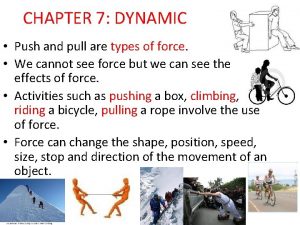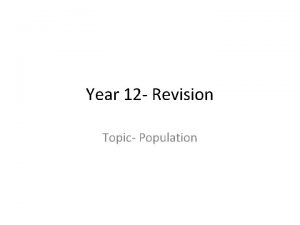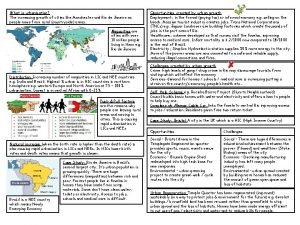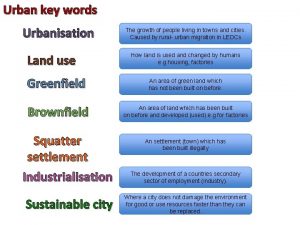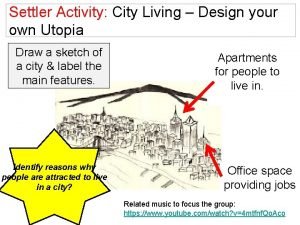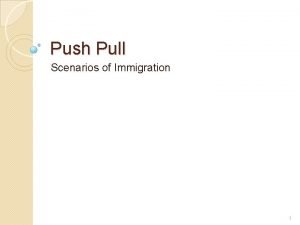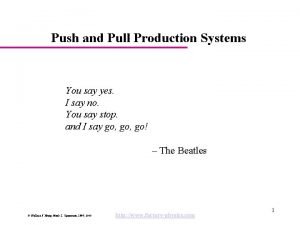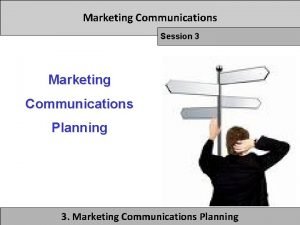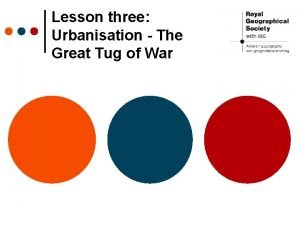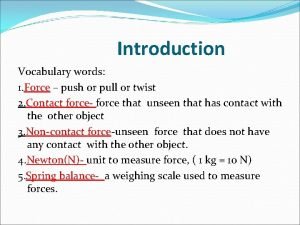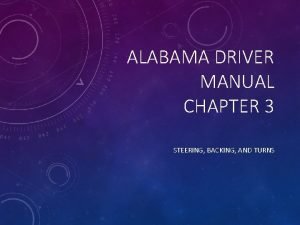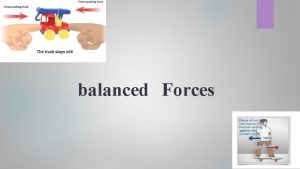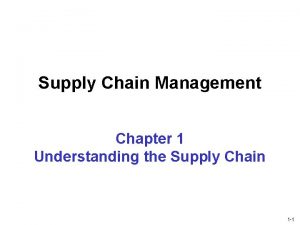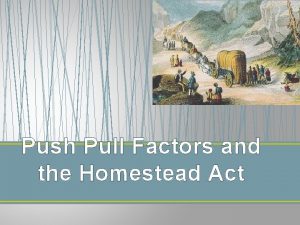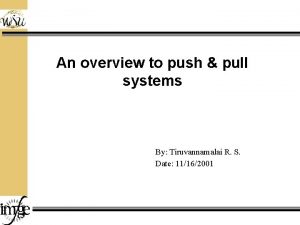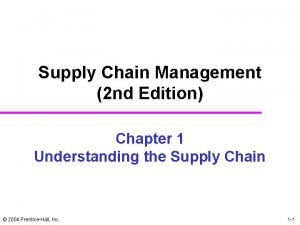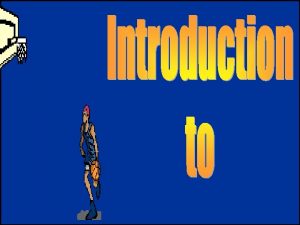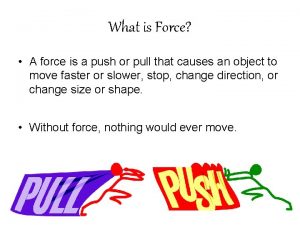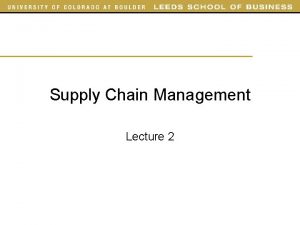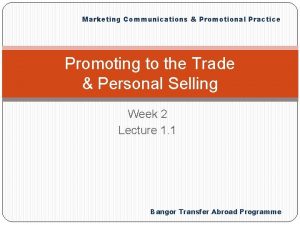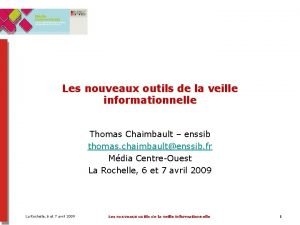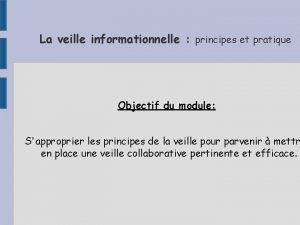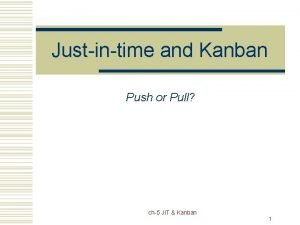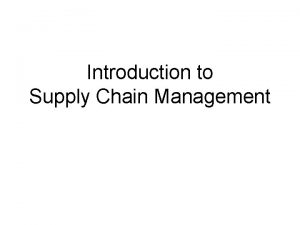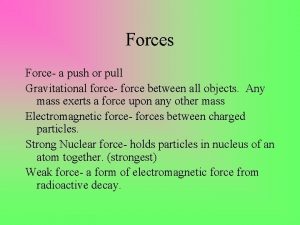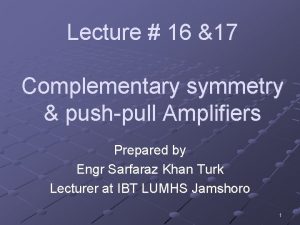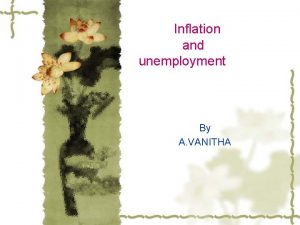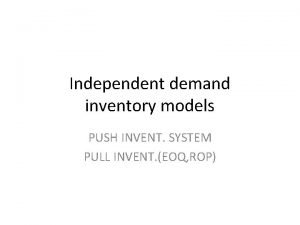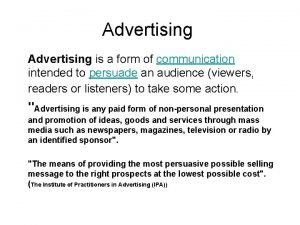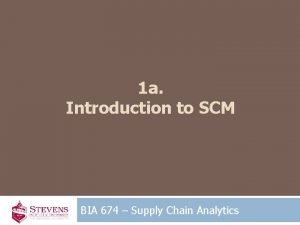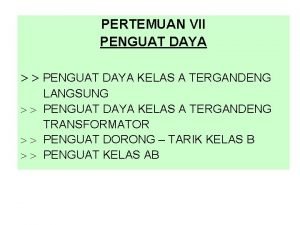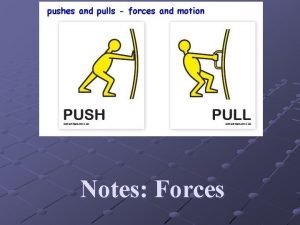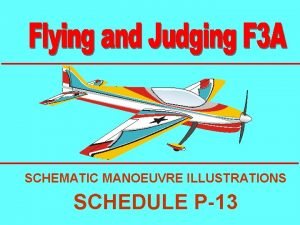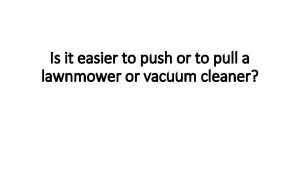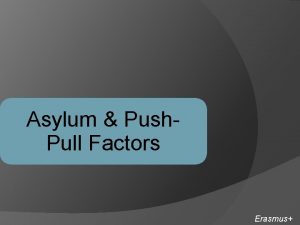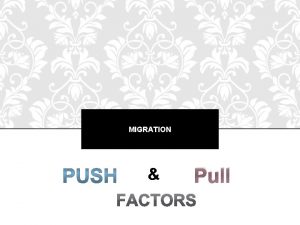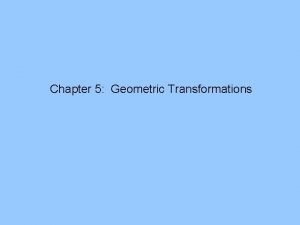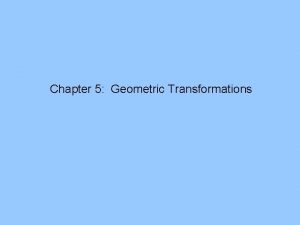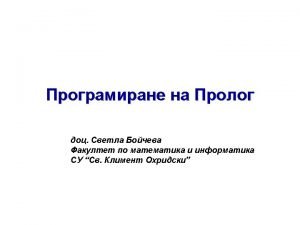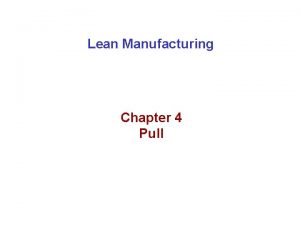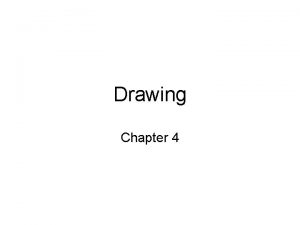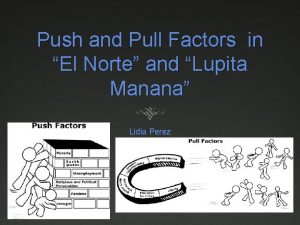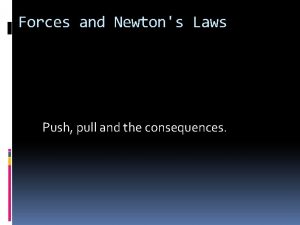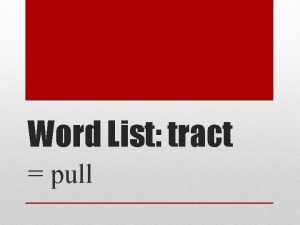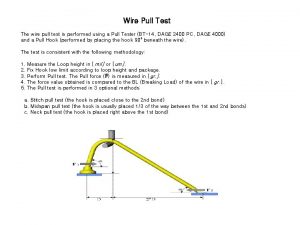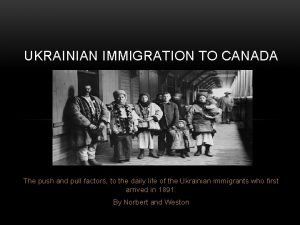CHAPTER 7 DYNAMIC Push and pull are types






















































- Slides: 54

CHAPTER 7: DYNAMIC • Push and pull are types of force. • We cannot see force but we can see the effects of force. • Activities such as pushing a box, climbing, riding a bicycle, pulling a rope involve the use of force. • Force can change the shape, position, speed, size, stop and direction of the movement of an object.


Type of force

Not work done • • • Push a wall Sit on the chair Sleep on a bed Read a book Stand up

FORCE TYPE OF FORCE Magnetic Force Electrostatic force friction MEASURING FORCE Electrical Force Gravitational Force Spring Balance FRICTIONAL FORCE Direction Magnitude WORK Work = Force X Distance Work = Power X Time

Frictional Force (friction) • friction occurs whenever two surfaces rub against each other. Friction is a force that always oppose motion.



Gravitational Force (gravity) • gravitational force or gravity is the force of attraction that pulls objects towards the Earth. • The force of gravity acts equally in all objects. Thus, in a vacuum, all objects whether heavy or light will fall to the Earth with the same velocity(halaju). Viscosity - kelikatan

Electrostatic Force • produced by charged substances. • Are caused by the presence of static electrical charges. The electrical charges are produced when two different objects are rubbed against each other. Like charges repel while unlike charges attract. • Example, it can attract small pieces of paper, stream of water flowing from a tap.


Electrical force • Is produced when electrons move through a conductor placed in a magnetic field. electron flows from negative terminal to the positive terminal


Magnetic force • Are the attractive and repulsive forces exerted • by magnets. Like poles of magnets repel each other while unlike poles of magnets attract each other.

THE MEASUREMENT OF FORCE • The unit of force is measured in Newton (N). • Force is measured using the spring balance. • 1 N shown on a spring balance is equal to nearly 100 g. (10 N = 1 kg) • Example, if

FRICTIONAL FORCE AND ITS APPLICATION. • A force which slows down moving objects is called frictional force or friction. • Frictional force can also be used to start or stop a motion. • Frictional force acts when two surfaces come into contact, sliding over each other. • Friction can at times be useful but in other instances it an also be a nuisance (GANGGUAN). • Friction is a force that opposes motion. It acts in the opposite direction to movement. • Friction always produces heat. • Friction has direction and magnitude.

How different types of surface affect frictional force. • Friction has magnitude and direction. • Magnitude depend on: 1. Nature surface – smooth or rough 2. Weight – light or heavy 3. Surface area not influenced magnitude of force. (big or small) • Different types of surfaces affect the magnitude of frictional force. • Rough surfaces have more friction than smooth. •

Perlis 2012


ADVANTAGES AND DISADVANTAGES • Advantages of friction (friction is useful) – Friction plays an important role in our daily activities. – Friction between a piece of rough metal and a flint produces sparks. These sparks ignite the gas in a lighter. – Friction enables the mechanical belt in car engines and machines to turn engine parts. This moves the vehicle and machines. • • Disadvantages of friction (friction is a nuisance). – Friction produces heat. For example, machine parts that move produce heat. This heat can damage certain parts of the machines if the machine is not carefully controlled. – Friction opposes and slows down movement. For examples ridding a bicycle up a slope or paddling a boat. – Friction wears away materials. For examples, friction wears out the soles of shoes and the tyres of vehicles.


PMR 10

PMR 2012

PMR 2012

PMR 2012

PMR 2012

FORMULA Work is done when a force moves an object through the distance in the direction of the force. Work (Nm) = Force (N) X Distance (m) Work (J) = Force (N) x Distance (m) Joule = Newton metre 1 newton-metre (Nm) = 1 joule (J)

test • (20 kg + 10 kg) , 2 m • 10 n , 1 km (1000 m) • 30 kg + 20 kg naik tangga 5 anak tangga, tinggi 5 anak tangga ialah 8 m, kira WD 8 m 15 m 20 kg 10 m

test 8 m 15 m 20 kg 10 m

TRY • • • WD (Nm) = force (N) x distance (m) = (40 kg + 5 kg ) x 10 N x 4 m = (45 kg x 10 N) x 4 m = 450 N x 4 m = 1800 Nm = 1800 J

Power is the rate of doing work, that is the work done in one second (or the energy used per second).

Check ?

Selangor 2011



TEST 1 45 kg 7 m 10 m a. Calculate work done? b. Calculate Power if time taken is 5 s 8 m

TEST 2 45 kg 20 cm 8 m 20 cm a. Calculate work done? b. Calculate Power if time taken is 5 s 10 m

TEST 3 20 cm 45 kg 20 cm 8 m 20 cm a. Calculate work done? b. Calculate Power if time taken is 5 minute 10 m

Test 4 45 kg 12 m 7 m 10 m a. Calculate work done? b. Calculate Power if time taken is 5 s 5 m

Test 5 45 kg 12 m 7 m 10 kg 10 m a. Calculate work done? b. Calculate Power if time taken is 5 s 5 m

Test 5 45 kg 10 m a. Calculate work done? b. Calculate Power if time taken is 5 s 5 m

wall Test 6 45 kg Ali tolak dinding a. Calculate work done? b. Calculate Power if time taken is 5 s

Test 7 Siti panjat dinding setinggi 5 m. Kira kerja yang Dilakukan? wall 45 kg a. Calculate work done? b. Calculate Power if time taken is 5 s 5 m


The chart below shows situations when work is done and when work is not done. work Work Done Work not done Pushing a wheelbarrow Climbing the stairs/ladder Throwing a ball upwards Brushing teeth Sitting on a chair Standing on a ladder Sleeping on a bed swimming

Moment of force N 9 2011 Moment of force - turning effect of a force. Moment of force (Nm) = perpendicular distance from the fulcrum to the force (m) X force (N) To increase the moment of force 1. Increase the perpendicular distance 2. Increase the magnitude of applied force Moment of force (Nm) = perpendicular distance from the fulcrum to the force (m) x force (N) Moment either clockwise or anticlockwise a. Tightening a nut (clockwise ) Perpendicular distance = 15 cm = 0. 15 m The moment of force = 20 N x 0. 15 m = 3 Nm b. Loosening a nut (anticlockwise ) Perpendicular distance = 15 cm = 0. 15 m The moment of force = 20 N x 0. 15 m = 3 Nm








Penutup 1. Baca Surah Al-`Ashr 2. Tasbih Kifarah.
 Insidan region jh
Insidan region jh Push and pull chapter 7
Push and pull chapter 7 Kg10m time switch
Kg10m time switch Push and pull factors of urbanisation
Push and pull factors of urbanisation Push and pull factors of urbanisation
Push and pull factors of urbanisation Push and pull factors of urbanisation
Push and pull factors of urbanisation Curitiba sustainable city
Curitiba sustainable city Citylivingdesign
Citylivingdesign Push and pull scenarios
Push and pull scenarios Push and pull technology examples
Push and pull technology examples Marketing objectives examples
Marketing objectives examples Push and pull factors of urbanisation
Push and pull factors of urbanisation Push and pull vocabulary
Push and pull vocabulary Influencing techniques
Influencing techniques Drivers manual alabama
Drivers manual alabama Balanced forces definition
Balanced forces definition Cycle view and push/pull view of supply chain
Cycle view and push/pull view of supply chain Pull factor definition
Pull factor definition Push pull
Push pull Push and pull factors of migration ppt
Push and pull factors of migration ppt Marketing communication mix of coca cola
Marketing communication mix of coca cola Cycle view of supply chain
Cycle view of supply chain Push und pull faktoren
Push und pull faktoren Change in momentum formula
Change in momentum formula Chinese immigration push factors
Chinese immigration push factors Angle of pull in biomechanics
Angle of pull in biomechanics Gravity force
Gravity force Collaborative supply chain
Collaborative supply chain Strategia pull
Strategia pull Push vs pull promotional strategy
Push vs pull promotional strategy Push pull profile strategies marketing communications
Push pull profile strategies marketing communications Example of market pull
Example of market pull Kanban push pull
Kanban push pull Méthode pull veille
Méthode pull veille Oros push pull
Oros push pull Définition veille informationnelle
Définition veille informationnelle Jit push or pull
Jit push or pull Push pull in supply chain
Push pull in supply chain Gravitational force push or pull
Gravitational force push or pull Push pull osmotic pump
Push pull osmotic pump Complementary symmetry amplifier
Complementary symmetry amplifier Introduction of inflation
Introduction of inflation Push vs pull inventory
Push vs pull inventory A push or pull exerted on an object
A push or pull exerted on an object Push pull osmotic pump
Push pull osmotic pump Smarrtt
Smarrtt Push pull view of supply chain
Push pull view of supply chain Push pull feedback
Push pull feedback Push pull class b power amplifier
Push pull class b power amplifier Balanced force facts
Balanced force facts Technology push vs market pull
Technology push vs market pull Promotion mix
Promotion mix Push pull rod system in aircraft
Push pull rod system in aircraft Pull-push takeoff
Pull-push takeoff Is it easier to push or pull
Is it easier to push or pull


